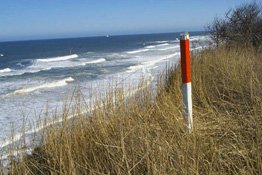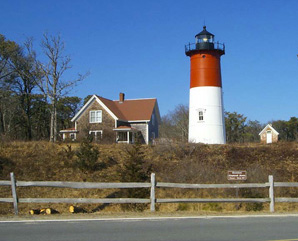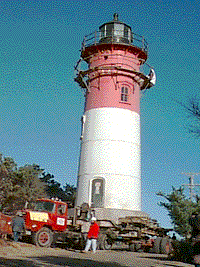|
Nauset Light
Nauset Light's distinctive image has become one with Cape Cod. You can see it on everything from calendars to Cape Cod potato chip bags. The lighthouse has been moved (like so many other Cape Cod lighthouses). Coastal erosion is an ongoing problem along the outer coastline of Cape Cod. The sea is continuously washing away the sandy shore. Before the move, Nauset Lighthouse was less than 25 feet from the edge of the cliff. The Coast Guard owned the lighthouse and had no plans for saving it. Modern instruments like GPS had diminished the need for lighthouses altogether. However, the lighthouse is still used by the fishing fleets and small recreational boaters who navigate close to the shore. Nauset Light is an important part of Eastham's cultural and maritime history, and is the most well known and photographed lighthouse on Cape Cod. Because of the nearing cliff edge, the brick towers were replaced by three 22-foot high wooden lighthouses in 1892 and located thirty feet from the edge. The brick towers were claimed by the Atlantic Ocean later that year. In 1911, the continuously retreating shoreline made it necessary to move the lights again. Two of the towers were sold, a rotating Fresnel lens flashing three times in ten seconds was installed in the third, and it was moved away from the cliff and attached to the relocated keeper's house. The light was automated by the Coast Guard in 1955, and the keeper's house fell into private hands. The fourth-order Fresnel lens was replaced by modern aerobeacons in 1981. The strobe of light was changed to alternating red and white flashes every five seconds. The old Fresnel lens is now on display at the Cape Cod National Seashore's Salt Pond Visitor Center on Route 6 in Eastham. The present Nauset Lighthouse, which is listed on the National Register of Historic Places, is made of cast iron with a brick lining and stands 48 feet high. It was built in 1877, and was located in Chatham as a twin to the one that is there today. In 1923, the smaller wooden lighthouse in Eastham was retired, and the north tower in Chatham was dismantled, moved to Eastham, and reconstructed about 200 feet from the edge of the cliff. In the 1940s, Nauset Light was painted red and white as a daytime indicator of the red and white beacon. Erosion continued to threathen the still-active Nauset Light. In just three years, from 1991 to 1994, 30 feet of the bluff disappeared just east of the lighthouse. In particular, the "Perfect Storm" (great movie!) of October 1991 washed great amounts of sand and earth from the cliffs and destroyed the stairs to the beach below. After the Coast Guard proposed the decommissioning of the lighthouse in 1993, hundreds of letters poured in, requesting that the lighthouse be moved inland and saved instead. The Nauset Light Preservation Society (NLPS) was soon formed, founded by several local residents. At a ceremony on April 17, 1995, the Coast Guard granted the society a five-year lease for the lighthouse. After much debate, a new site was chosen for the tower in April 1996. By that time, it stood only 43 feet from the edge of the bluff. A contract with International Chimney Corporation of Buffalo, New York, was signed in September 1996. The team of International Chimney and Expert House Movers had previously moved the Highland Light (Cape Cod Light). By early November 1996, the new site had been graded and excavated, a temporary access road to the site had been created, and new footings for the tower and oil house were prepared. The foundation of the tower was cut away from its footings. Cribbing was installed around the base of the tower and four steel beams were pushed through the foundation. Six interior and four exterior jacks were put in place to raise the 90-ton tower. On November 15, workers lifted the tower and transferred its weight to two heavy-duty dollies, hitched to a truck. The tower was moved to the edge of the road before the end of the day. Several hundred people witnessed the lighthouse move across Nauset Light Beach Road to the new site. By the end of the day, the tower was next to its footing, and had been rotated to face north as it did before it was moved. The move was completed on Saturday, November 16, when the truck hauled the lighthouse across the road to its new home, 336 feet from the old site. The tower's exterior was renovated and painted, and a new exterior railing was installed. After its relocation, the lighthouse remained dark until May 10, 1997, when it was relighted at a gala event attended by about 2,000 supporters. After two years of negotiations, Mary Daubenspeck donated the house and the existing site to the National Park Service in early 1998, in exchange for the right to live in the house for another 25 years. On October 27, 1998, the house (a scary 23 feet from the edge of the bluff) was moved to a new foundation near the lighthouse. Ownership of the lighthouse passed to the Cape Cod National Seashore. A partnership agreement between the National Park Service and the Nauset Light Preservation Society was signed in May 2004. Under the agreement, the NLPS will continue to operate the lighthouse as a private aid to navigation and will be responsible for all maintenance of the tower and oil house.

Return to Cape Cod Lighthouses from Nauset Light page.
|


